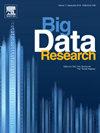Adaptive spectral GNN and frequency enhanced self-attention for traffic forecasting
IF 4.2
3区 计算机科学
Q2 COMPUTER SCIENCE, ARTIFICIAL INTELLIGENCE
引用次数: 0
Abstract
In intelligent city, traffic forecasting has played a significant role in intelligent transportation system. Nowadays, many methods, which combine spectral graph neural network and self-attention, are proposed. However, they still have some limitations for traffic forecasting: 1) The polynomial basis of traditional spectral graph neural networks (GNN) is fixed, which limits their ability to learn spatial dependency of traffic data. 2) Some GNNs ignore the dynamic dependency of traffic data. 3) Traditional self-attention suffers from limited perception for long-term information, time delay, and global information. These defaults pose big challenge for traffic forecasting via limiting their ability of capturing spatial-temporal dependency, dynamic and heterogeneous nature in traffic data. From this perspective, we propose an adaptive spectral GNN and frequency enhanced self-attention (ASGFES) for traffic forecasting, which can effectively capture the spatial-temporal dependency, dynamic and heterogeneous nature in traffic data. Specifically, we first introduce an adaptive spectral graph neural network (ASGNN) for effectively capturing the spatial dependency via conducting adaptive polynomial basis. In addition, two dynamic long and short range attentive graphs are fed into the ASGNN for emphasizing the dynamicity in view of long and short range. Secondly, we introduce a normalized self-attention with damped exponential moving average (NSADEMA). Specifically, the normalized self-attention (NSA) can capture the necessary expressivity to learn all-pair interactions without the need for some extra operation such as positional encodings, multi-head operations, and so on. It can well obtain the temporal dependency and heterogeneity of traffic data. In addition, the DEMA, which is equipped into NSA, can enhance the perception for the inductive bias of traffic data in time domain. It can be aware of the time delay of traffic data. Thirdly, linear frequency learner with time-series decomposition (LFLTD) are developed for enhancing the ability of capturing the temporal dependency and heterogeneity. Specifically, time-series decomposition (TSD) facilitates the analysis and forecasting of complex time via capturing various hidden components such as the trend and seasonal components. Meanwhile, linear frequency learner (LFL) can learn global dependencies and concentrating on important part of frequency components with compact signal energy. At last, many experiments are performed on several public traffic datasets and demonstrate the proposed ASGFES can achieve better performance than other traffic forecasting methods.
自适应频谱GNN和频率增强自关注交通预测
在智慧城市中,交通预测在智能交通系统中起着重要的作用。目前,人们提出了许多将谱图神经网络与自关注相结合的方法。传统谱图神经网络(GNN)的多项式基是固定的,这限制了其学习交通数据空间依赖性的能力。2)部分gnn忽略了交通数据的动态依赖性。3)传统的自我注意存在对长时信息、时滞信息和全局信息感知有限的问题。这些默认值限制了它们捕捉交通数据的时空依赖性、动态性和异质性的能力,给交通预测带来了很大的挑战。为此,本文提出了一种基于自适应频谱GNN和频率增强自关注(ASGFES)的交通预测方法,该方法能够有效地捕捉交通数据的时空依赖性、动态性和异质性。具体来说,我们首先引入了一种自适应谱图神经网络(ASGNN),通过自适应多项式基有效地捕获空间依赖性。此外,在ASGNN中输入了两个动态的长程和短程关注图,以强调长程和短程的动态性。其次,我们引入了带阻尼指数移动平均的归一化自注意。具体来说,规范化自注意(NSA)可以捕获学习全对交互所需的表达能力,而不需要一些额外的操作,如位置编码、多头操作等。它可以很好地获得交通数据的时间依赖性和异质性。此外,将DEMA集成到NSA中,可以增强对交通数据在时域上的感应偏置的感知。它可以感知交通数据的时间延迟。第三,提出了基于时间序列分解的线性频率学习器(LFLTD),增强了捕获时间依赖性和异质性的能力。具体而言,时间序列分解(TSD)通过捕获各种隐藏成分,如趋势和季节成分,促进了复杂时间的分析和预测。同时,线性频率学习器(LFL)可以学习全局依赖关系,并以紧凑的信号能量集中在频率成分的重要部分。最后,在多个公共交通数据集上进行了大量实验,验证了该算法的性能优于其他交通预测方法。
本文章由计算机程序翻译,如有差异,请以英文原文为准。
求助全文
约1分钟内获得全文
求助全文
来源期刊

Big Data Research
Computer Science-Computer Science Applications
CiteScore
8.40
自引率
3.00%
发文量
0
期刊介绍:
The journal aims to promote and communicate advances in big data research by providing a fast and high quality forum for researchers, practitioners and policy makers from the very many different communities working on, and with, this topic.
The journal will accept papers on foundational aspects in dealing with big data, as well as papers on specific Platforms and Technologies used to deal with big data. To promote Data Science and interdisciplinary collaboration between fields, and to showcase the benefits of data driven research, papers demonstrating applications of big data in domains as diverse as Geoscience, Social Web, Finance, e-Commerce, Health Care, Environment and Climate, Physics and Astronomy, Chemistry, life sciences and drug discovery, digital libraries and scientific publications, security and government will also be considered. Occasionally the journal may publish whitepapers on policies, standards and best practices.
 求助内容:
求助内容: 应助结果提醒方式:
应助结果提醒方式:


